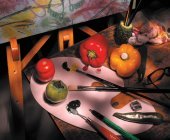|
LightLight is the most important ingredient or element of a picture. Basic source is the sun, yet, neither this source is constant nor it is consistent. The factors which affect the quality are the angle of the sun, time of the year, presence of clouds, time of the day, weather conditions, pollution, altitude and geographical location, that is latitude. When we use artificial light in a studio, we can control the quality with use of an umbrella, soft box and snoot. In either case, we need to achieve the same good result as the natural one. Quality of any source can be soft,(read more) medium-soft,(read more) or hard (spot). (read more) A large source (like overcast day or from soft box in studio) will give soft effect. When clouds in the sky are thin and we can spot the sun, it is medium-soft. This result can be achieved in a studio with the help of white translucent sheet or white umbrella in front of the studio flash. Direct sun or direct studio flash (bare head) will give hard effect.
However, in studio, we have to take the distance between the source and the object into account. If soft box is too far from the object, it may give medium-soft quality effect. Similarly a medium-soft source, which is far from the subject will become a spot. Example is the sun. Though it is the largest source, but because of the distance, it becomes a point source of spot. A large source will cast soft shadow (or rather shading) and almost illuminate the entire object. Medium-soft source will cast well defined shadow and contrast will increase where as a point source will cast sharp and well defined shadow. Angular fall of source will create a highlight, mid-tone and shadow area on the object. Highlight in an image is the area, where detail is less and nature/color of source is more dominating. Mid-tone is the area where true color, texture and shape of the object is visible. Shadow area is the dark part, where details are hardly visible and should we need to open up details, we need some bounce to fill the shadow from a reflector. Any object we shoot is either shiny in finish, semi matt or matt. Skin falls into semi matt category. Quality and nature of the source will be distinctly visible if the object is shiny. On shiny surface, the mid-tone area is minimum. So if we use a spot on a stainless steel ball, we will get a spectacular highlight in form of a spot and all other parts will become dark. A large source from a soft box will be visible in the object but that reflection of the soft box will reveal the nature of the surface of the ball. With semi matt and matt objects, we can choose any form of source depending on our personal preference, mood we want to create and how much detail we want to record. In a studio, we can mix it with multiple source of different quality, but we must be very careful not to cast multiple shadows when we use more than one studio flash. Only the main source should create the picture and all other fill-in should be less powerful and soft.
Read more about this subject here
Read about natural twilight photography
Other photographic accesso ries
|






